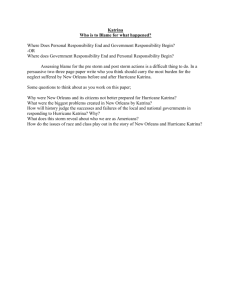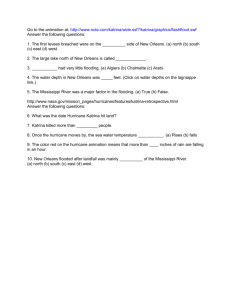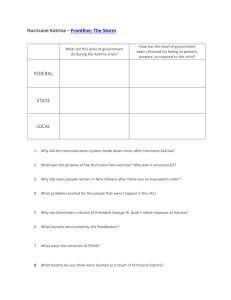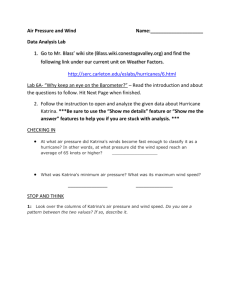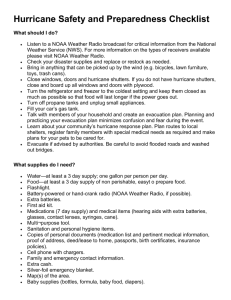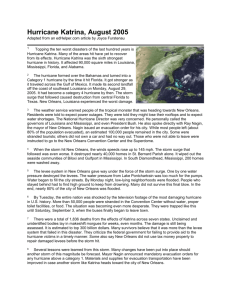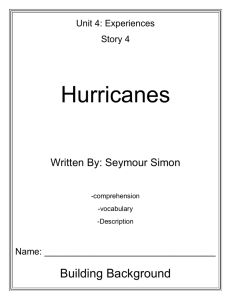CRASHLANENEWS.COM Louisiana NOAA Office Interview The
advertisement
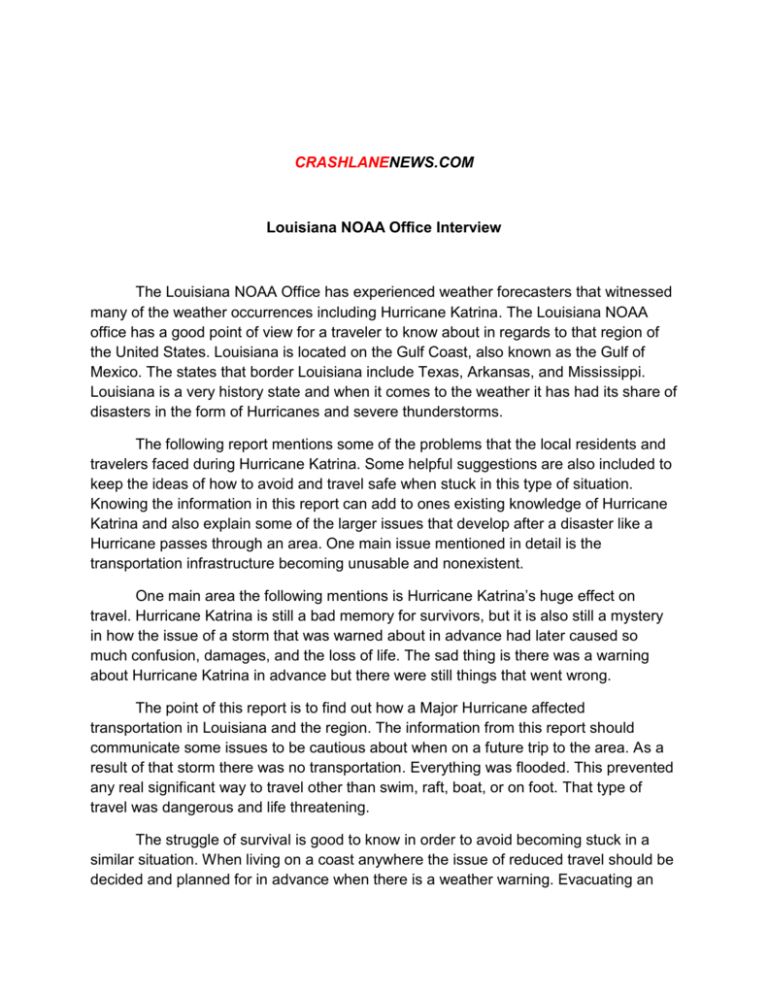
CRASHLANENEWS.COM Louisiana NOAA Office Interview The Louisiana NOAA Office has experienced weather forecasters that witnessed many of the weather occurrences including Hurricane Katrina. The Louisiana NOAA office has a good point of view for a traveler to know about in regards to that region of the United States. Louisiana is located on the Gulf Coast, also known as the Gulf of Mexico. The states that border Louisiana include Texas, Arkansas, and Mississippi. Louisiana is a very history state and when it comes to the weather it has had its share of disasters in the form of Hurricanes and severe thunderstorms. The following report mentions some of the problems that the local residents and travelers faced during Hurricane Katrina. Some helpful suggestions are also included to keep the ideas of how to avoid and travel safe when stuck in this type of situation. Knowing the information in this report can add to ones existing knowledge of Hurricane Katrina and also explain some of the larger issues that develop after a disaster like a Hurricane passes through an area. One main issue mentioned in detail is the transportation infrastructure becoming unusable and nonexistent. One main area the following mentions is Hurricane Katrina’s huge effect on travel. Hurricane Katrina is still a bad memory for survivors, but it is also still a mystery in how the issue of a storm that was warned about in advance had later caused so much confusion, damages, and the loss of life. The sad thing is there was a warning about Hurricane Katrina in advance but there were still things that went wrong. The point of this report is to find out how a Major Hurricane affected transportation in Louisiana and the region. The information from this report should communicate some issues to be cautious about when on a future trip to the area. As a result of that storm there was no transportation. Everything was flooded. This prevented any real significant way to travel other than swim, raft, boat, or on foot. That type of travel was dangerous and life threatening. The struggle of survival is good to know in order to avoid becoming stuck in a similar situation. When living on a coast anywhere the issue of reduced travel should be decided and planned for in advance when there is a weather warning. Evacuating an area for a few days may be the best alternative instead of planning to stick it out and this can be possible if there is some planning. Hurricanes like Hurricane is not something a traveler should try to seek out in order to survive and have an adventure. One main reason to avoid a Hurricane Katrina disaster is that there were over 900 deaths, and tens of thousands injured. Thousands evacuated while the residents that stayed became trapped and immobile by a flood. As a result there was a lack of supplies coming into the area and the repairs on the infrastructure could not be made. In summary avoiding that area and Hurricane needed to be a priority, but the reality is that some could not afford or plan for the evacuation. Natural disasters are expected sometimes and even planned for but not everyone is always able to have the same resources and information at the right time. As a result the fatalities and injuries were high. Airports Were Closed As far as the air service, meaning the ability to get on a flight in or out of the New Orleans area, the Louis Armstrong, New Orleans International Airport, was closed for a few days. This airport is west of New Orleans and borders the city, residing in Kenner, LA. It is still very close to New Orleans. During the Hurricane and afterwards, the airport was used as an evacuation point. Commercial flights may not have resumed until a couple weeks after the storm. One reason is the airport needed repairs, and they had to clean up the airport due to the large amount of evacuees. Another issue was that the airport had been turned into a makeshift hospital during and after the Hurricane. The Airport’s staff had to convert and do maintenance on the airport, bringing it back into operating as an airport. The Lakefront Airport in the city of New Orleans, is a smaller size facility and the general aviation airport. Some private charter flights fly out of there. That facility is outside the levee system so the storm surge destroyed all the buildings there. The control tower was damaged, and they had to build a new control tower after the storm. That is the secondary airport for New Orleans. Both of airports were shutdown for the most part. They were just not running flights. The whole city and even the surrounding area of New Orleans could not really travel using an airliner or the interstate, unless they were on foot. Vehicle Traffic Disruptions Storm Surge Affected traveling with automobiles. Travelers driving could go across the causeway bridge. It goes across the middle of Lake Ponchartrain. That was also damaged at some stops. The storm surge was one of the biggest things that affected Interstate traffic, as well as the local transportation. NOAA stated that Hurricane Katrina greatly affected the transportation infrastructure and travel in the area. Interstate 10 in the main highway that runs along the southern part of Louisiana form Texas east to Alabama. A section of Interstate 10 goes over Lake Pontchartrain, and was destroyed by the storm surge and wake. This main Interstate was unusable for a few months. Interstate 10 is one of the main interstate highways out of New Orleans. Travelers that were driving had to use Highway 11 which has a bridge. The Hurricane had also damaged Highway 11 but it was still usable. Travel from downtown New Orleans to the suburbs of Metairie was not possible. The interstate was the normal route for this and was underwater in that area until they drained the city. This drainage took about a month. After that the suburbs on that side of town could get to the interstate to Baton Rouge there was so much traffic there were continuous traffic jams on the interstate though. The transportation for the area was basically overloaded for the areas where people had evacuated to. There were serious transportation issues across the whole region for a while. In Slidell where the NOAA office is located, there was flooding on the south side of town. It was hard to get to the office from that side of town. Interstate 12 was basically shutdown for several weeks after the storm. Many people had relocated up here while the city was still flooded. FEMA There are many critical points of view on what occurred during a Major Hurricane. One area is the use of a disastrous event being used as a political tool for one side to bad mouth an opponent. This discussion and report is not to take sides on the political issues that may have occurred during and after Hurricane Katrina. A discussion about this disaster does need to include a brief point of view on what can be stated to have happened. Another issue is the public’s perception and critical view about their situation being worsened by a lack of disaster preparedness. This report is not to say that things went wrong it is widely known things could have been better as of 2014. Many believe that nobody could have predicted the levees would have failed as bad as they did. Given the situation that had occurred in 2005 and the fact that the city’s transportation was basically cut off, some have said that FEMA did as good as a job as they could when they got in there. Given the circumstances of a flooded out city that lasted for weeks, and the situation of travel being blocked FEMA did the best they could. The situation eventually got better and improved. That is one of the more positive ways of describing what occurred and many know that in a disaster at that size and scale the local, state, and federal government really need to have that leadership presence they claim to have while is office. If there are first responders and emergency preparedness in a governments budget there needs to be some signs of that expense before, and during a predictable disaster occurs. Many citizens that were trapped in the floods would state that show of planning did not occur as a result of the failed levees. As a result of that point any reader should be able to agree that something failed and it king of pointed at the governments control of the infrastructure. Communication Blackout Not only was the transportation locked up, pretty much all the communications were knocked out as well. Due to the flooding so that impacted things greatly. To make a phone call people had to go over to Baton Rouge which is 8 miles away. Land line telecommunications were knocked out completely. The only way NOAA was communicating was by satellite phone or by 800 MHz, radio system. NOAA was fortunate to get a satellite phone here because of the federal government. Hurricane Katrina’s Predictability The warning for Hurricane Katrina came out on the Friday before. The storm made landfall Sunday night and Monday morning. So there was about 72 hours, 48 to 72 hour range there, about three days, of advanced warning. The warnings have gotten better and better. Now in 2013 NOAA considers that advance time of warning to be even below average. Back at that time in 2005 that would be considered average, especially for this area. The reason is there are storms that fire up in the Western Caribbean and the Gulf of Mexico so the area here in Louisiana would only have a day or so to get ready, meaning evacuate or make some kind of preparedness plan. The City of La Place area, 25 miles west of New Orleans, has a low spot on the Interstate 10 as well. That section flooded for a period of time. To the north on Interstate 55, lies the City of Ponchatoula, LA, where flooding obstructed travel on the northwest side of Lake Pontchartrain. There are plans to raise the highways in those areas so flooding will not happen again. The below chart mentions Hurricane Katrina was the 11th storm and occurred August 23-30, 2005. The chart also mentions there were winds at 150 Kt. This was considered a Major Hurricane in the days leading up to the its arrival on August 29 and during its path through Louisiana marked in purple. Compared to Hurricane Katrina Hurricane Isaac was smaller and was not very comparable when it comes to the damage that Katrina caused. Hurricane Isaac was a minimal Hurricane. That Hurricane did have a pressing surge that went into Lake Pontchartrain. The western side of the lake had that affect occurring the most. That was due to a continuous period of easterly winds. The storm slowed down so much it basically stopped off along the coast of Louisiana and kind of drifted for a while. Winds were piling water into the lake, and we did have some issues infrastructure wise. The below chart shows Hurricane Isaac is the 9th storm, categorized as a Hurricane, with winds at 70 Kt, August 21 to September 1, 2012. The chart shows that the day before the center of the storm hit Louisiana was on the 28 of August, and the storm was considered a Hurricane, marked in red. The day the center of the storm was in Louisiana was on the 29 and had lowered to a Tropical Storm, marked in yellow. Hurricane Isaac Isaac was a Category 1 Hurricane occurring 2012. There were some transportation issues with Isaac that had interstate closures occurring. The interstate definitely got closed at Isaac. Interstate 10 and Interstate 55 were closed for a period of time. The estimated closure time was for a day to a day and a half. The storm surge was lingering on the west side of the lake. Once the surge drained out, the Interstates were able to open up again. It was a small section that was closed and there were other routes that people could take that were open. In summary for Hurricane Isaac there were sections closed on interstate 10 and 55, that did flood. NOAA provided the public a long warning time, before Hurricane Isaac arrived. It was a slow moving system. The area and New Orleans had five to six days of lead time before the system came in. There were some evacuations for communities outside of the levees, and were smaller populations. The major part of New Orleans did not evacuate for the Isaac storm. Travelers Caught in Major Hurricanes Hurricane advice for travelers can begin in knowing what occurred with Hurricane Katrina. For Katrina there were people that were visiting New Orleans at the time of the Hurricane. As the transportation infrastructure flooded these same visitors and vacationers were stuck. The airport and the airlines look at the weather and see the storms coming, canceling flights about a day before the storm hits. There are some people on a trip that do get stranded temporarily. For Katrina they had to later be evacuated out. There were also people stranded for Isaac as well. Isaac was not nearly as bad and actually during Isaac the hotel section maintained power, which was good, unlike Katrina. There are people stranded as a result of Hurricanes. If a person is traveling by their own vehicle and there is an evacuation due to a Hurricane coming, some hotels will basically force their guests to leave because of possible risks that may occur later when the storm hits. These individuals can travel because they came by car and it is not that bad for them because they get out of the area saving their vehicle from becoming flooded as well as suffering any injuries or worse. An evacuation from the area ahead of time is something to think about when traveling. A suggestion for a traveler is to be aware of the Hurricane threat if on the gulf coast, not only in Louisiana. Some states that people may travel to around Hurricane season include Texas, Mississippi, Alabama, and Florida. The procedures the local areas businesses take are also good to know for a traveler, to be aware of what occurs, and how it affects transportation after it hits as a result. Traveler’s should watch weather forecasts for inbound Hurricanes. Watching the weather is recommended, especially during the tropical storm season here. Travelers going to the Gulf Coast from July to September should be aware of the weather advisories and the Hurricane threat. The peak times of travel risk for are from July to September. Once we head to October and November it is usually a time of a lower risk. Those months are not as active for Hurricanes. Keep your eye on the weather forecasts, making sure there is nothing coming. If you see a potentially Hurricane or storm, the best course of action would be to plan ahead, and postpone the trip, or change travel plans. Travelers should do this instead of getting caught in the middle of the storm. Mardi Gras Weather Mardi Gras attracts people across the United States every year for reasons in that there is usually better weather down south at that time of year in February. Most of the states north of Louisiana get snow which is also why it is a popular destination and celebration. With the chance of having some warmer weather Mardi Grad season is considered to take place during a severe weather period, because Mardi Gras falls usually February, or March. New Orleans and Louisiana can get severe thunderstorms, lighting, heavy rain fall, tornados, and strong winds, all during that time of year. Hail is not a big threat, and is a rare event. The tornado threat, and the strong wind threats, are going to be the biggest concern during Mardi Gras. Then of course in February New Orleans occasionally could get snow. Snow is a very rare event, but does occasionally happen. The snow melts pretty quick because of the milder climate, and location near the Gulf. Besides the tornados, the bigger weather threat is going to be the risk of severe thunderstorms. Some years there are some severe thunderstorms that roll through the area during the Mardi Gras weekend. When this occurs the option to postpone the parade to another day is a possibility. Biggest Travel Concern The biggest weather threat as far as car accidents go is fog. New Orleans has sea fog often times in the cool season months. Sea fog can be dense reducing visibility to a few feet. There have been several deadly car accidents, and multiple vehicle pileups, during fog events. The fog and accidents is the biggest concern for drivers and forecasters. The cool season is from November through March. November can sometimes catch some off guard with the fog as well as the later months of January, and February where a driver may have become complacent to the effects of the weather. Some outsiders might think traveling in or around a Hurricane would be the biggest problem. But Hurricane’s warning gets the message out and do not affect travel while driving as much. For driving crashes and wrecks, the fog is the biggest threat. Nobody is out driving in a Hurricane. They are either in their house hanging out or they evacuated. The New Orleans NOAA office has many fog advisories in winter. These advisories help to communicate if visibility is going to be less than a quarter of a mile. If there are low visibility warnings, slow down, and use extra caution. With advisories put in place there are still accidents as a result of the fog. People sometimes are just driving too fast at the wrong place and time when it comes to fog. The low visibility combined with the problem that some drivers that do not adjust the speed of their vehicle to hazardous weather conditions, being the fog, causes accidents. In Summary A solution is to regularly check the weather threats when traveling to Louisiana and in the region. Check the NOAA alerts at www.spc.noaa.gov, or check the local news channel like CBS, ABC, and NBC, on television for weather advisories, or a cable news channel like the Weather Channel, CNN, and Fox News. In addition to having the news and advisories from NOAA, have a Smartphone that is capable of the Wireless Emergency Alerts. Smartphone applications can give some added weather awareness and warnings directly from the government. A traveler can postpone, and reschedule a trip, and route, should there be the forecast of a Hurricane. As for the fog a traveler should try to monitor the local NOAA offices fog reports and try to drive when the sun is up.
